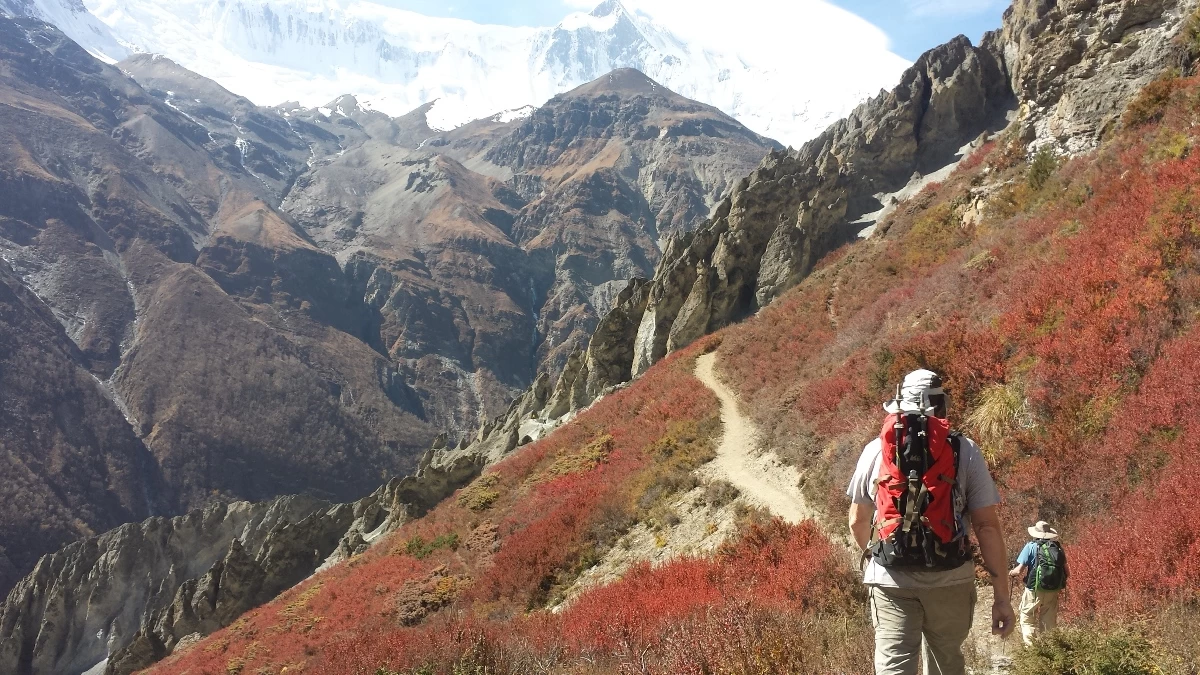Trip Overview
The Annapurna Circuit is one of the most iconic trekking routes in Nepal, known for its diverse landscapes, cultural richness, and stunning mountain views. The trek circumnavigates the Annapurna massif, offering trekkers a once-in-a-lifetime experience in the heart of the Himalayas.
The trail initially gained popularity in the 1970s, and in the decades since, it has become one of the busiest trekking routes in Nepal. However, despite its popularity, the trek continues to captivate trekkers from around the world with its blend of lush subtropical forests, alpine meadows, and dramatic mountain vistas.
In recent years, the trek has become more accessible due to the development of roads in certain sections, especially the lower parts of the trail. However, the trek still offers a sense of adventure, particularly when you venture into the high-altitude areas of the circuit, including the stunning Tilicho Lake.
What is the Annapurna Circuit Trek with Tilicho Lake Like
The Annapurna Circuit trek offers a truly varied trekking experience. You start at the subtropical forests and pass through lush valleys before making your way to the high Himalayan terrain. One of the main highlights of this trek is Tilicho Lake, located at an altitude of 4,919 meters. This sacred glacial lake sits beneath the towering peaks of Annapurna, making it one of the most sought-after destinations for trekkers on the circuit.
The Annapurna Circuit trek takes you through charming Gurung, Magar, and Thakali villages, where you can experience rich Nepalese culture, sample local cuisine, and interact with the warm, welcoming locals. Along the way, you'll be treated to spectacular views of the Annapurna Range, Dhaulagiri, Machapuchare (Fishtail), and other peaks, all while traversing various terrains—from dense forests to high-altitude deserts.
The trek includes an exciting ascent to the Thorong La Pass (5,416 meters), the highest point of the circuit, which connects the Manang Valley to the lower Mustang region. From there, the trail descends through the beautiful Kali Gandaki Gorge, the world’s deepest, before making its way to the bustling town of Pokhara.
For those who want to extend their journey, Tilicho Lake adds a wonderful detour. From the village of Khangsar, you'll trek up to the lake, passing through rugged terrain and gaining high-altitude acclimatization before reaching the tranquil waters of Tilicho Lake.
Key Highlights of the Trip
Scenic Views: The trek offers some of the most magnificent views of the Annapurna Range, Dhaulagiri, Machapuchare, Manaslu, and other peaks. The view from Thorong La Pass is particularly awe-inspiring.
Cultural Experience: The Annapurna region is home to various ethnic groups such as the Gurung, Thakali, and Magar, whose rich cultural traditions you can explore during your trek. You will also visit Buddhist monasteries and temples.
Tilicho Lake: The sacred Tilicho Lake is a highlight of this trek. Located at a high altitude, it’s surrounded by towering peaks and has a surreal, remote beauty.
Diverse Terrain: From lush subtropical forests to alpine meadows and stark, high-altitude desert landscapes, the variety in terrain is one of the unique aspects of this trek.
The Challenge of Thorong La Pass: The trek’s highest point, Thorong La Pass, at 5,416 meters, provides a thrilling challenge for trekkers and offers unparalleled views of the surrounding mountains.
Kali Gandaki Gorge: Trek through the Kali Gandaki Gorge, the deepest gorge in the world, offering breathtaking landscapes and a unique hiking experience.
Pokhara: The trek ends in the scenic lakeside town of Pokhara, where trekkers can relax and unwind after their adventure.
Who Is This Trek For
The Annapurna Circuit with Tilicho Lake is a challenging trek that is best suited for family of adults and experienced trekkers. The trek involves long daily hikes, high altitudes, and diverse terrain. Trekkers should have a good level of fitness and be prepared for both physical and mental challenges.
While the Annapurna Circuit is generally accessible, the addition of Tilicho Lake adds an extra layer of difficulty due to the high altitude and the rugged nature of the terrain. The trek is perfect for those who are looking for a more remote experience and are ready to deal with the physical demands of trekking at high altitudes.
Preparing for the Trek
To prepare for the Annapurna Circuit with Tilicho Lake, trekkers should focus on building stamina and strength. Aerobic exercises, strength training, and endurance hikes will help you get ready for the long days of walking and climbing. It’s also advisable to practice hiking at higher altitudes to get accustomed to the reduced oxygen levels.
Tips for the Annapurna Circuit Trek:-
Altitude Sickness: Like all high-altitude treks, there is a risk of altitude sickness on the Annapurna Circuit. The trek’s highest point, Thorong La Pass, is at 5,416 meters, so it's crucial to take proper acclimatization breaks and avoid pushing yourself too hard. Drink plenty of water and avoid alcohol to reduce the risk.
Packing: Pack light but wisely. Essentials include warm clothing, a high-quality sleeping bag, sun protection (SPF, sunglasses, and hat), snacks, and energy bars. A good camera is also recommended to capture the stunning landscapes.
Trekking Permits: The Annapurna Circuit requires two permits: the Annapurna Conservation Area Permit (ACAP) and the TIMS card (Trekker’s Information Management System).
Rest and Hydration: Take your time to acclimatize and rest frequently. Ensure you stay hydrated and eat well to maintain your energy levels.
Local Interaction: Take the time to interact with local people. The trek offers a fantastic opportunity to learn about the customs, traditions, and cultures of the people living in this remote region.
Altitude Sickness
Due to the high altitude of the Annapurna Circuit, especially near Tilicho Lake and Thorong La Pass, altitude sickness is a concern. The best way to prevent altitude sickness is to ascend slowly, allow your body to adjust, and stay well-hydrated. Symptoms include headaches, nausea, dizziness, and shortness of breath. If you experience severe symptoms, talk to your Group Leader and will take all necessary measures. If it gets severe descend immediately and seek medical help.


